2014 Peugeot 308 run flat
[x] Cancel search: run flatPage 6 of 400

4
Visual search
308_EN_CHAP00B_ AIDE VISUELLE_ED02-2013
Exterior
Wipers 181-18 4 Changing a wiper blade 184, 256
Keyless Entry and Starting remote control 53 -57, 61- 63 Remote control key 46 -52, 63 Starting 108 -112
Electronic stability programme (ESC) 193 -195 Snow chains 234 Tyre pressures 221, 233, 287 Inder-inflation detection 189-192 Changing a wheel 227-233 - tools - removing / refitting Automatic emergency braking 151-155
L i g ht i n g 173 -179 Daytime running lamps (LEDs) 177 Headlamp beam adjustment 180 Changing bulbs 235-239 - front lamps - foglamps - direction indicator repeaters
Electric windows, deactivation 69 -70
Keyless Entry and Starting 53 -57 Doors 47- 49, 51 - opening / closing - central locking - emergency control Alarm 65 - 68
Fuel tank, misfuel prevention 72-73
Panoramic sunroof 71 Roof bars, bicycle carrier 262-263 Accessories 264-265
Boot 58 - 60 - opening / closing - emergency release Temporary puncture repair kit 221-226 Warning triangle 94
Parking sensors 159 -160 Reversing camera 161 Towbar 260 -261 Towing 257-258 Park Assist 162-169
Changing bulbs 240-244 - rear lamps - 3 rd brake lamp - number plate lamps - foglamp
Door mirrors 170 -171, 179 Blind spot sensors 156 -158
Page 26 of 400
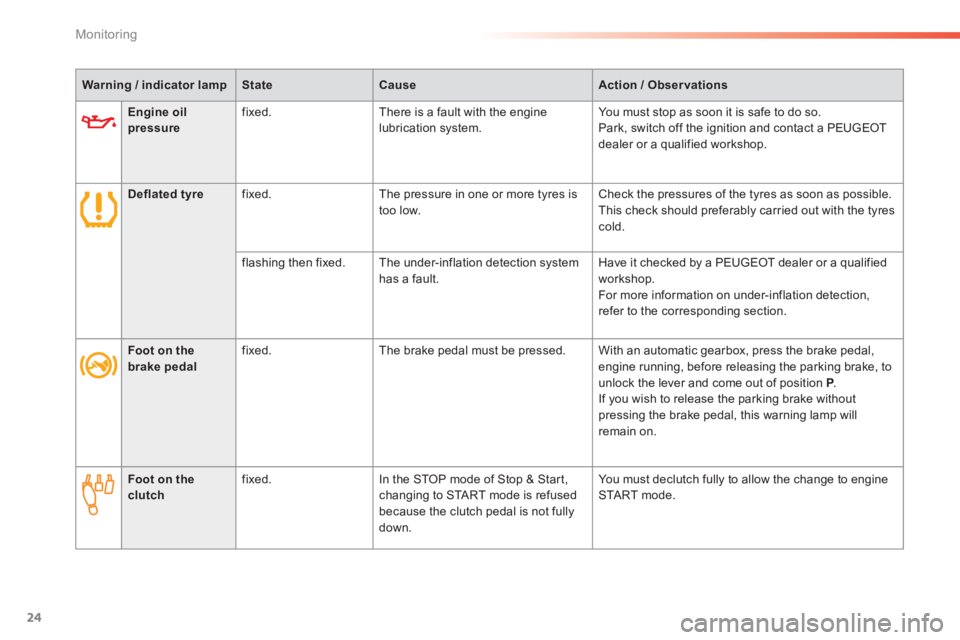
24
Monitoring
308_EN_CHAP01_CONTROLE DE MARCHE_ED02-2013
Engine oil pressure fixed. There is a fault with the engine lubrication system. You must stop as soon it is safe to do so. Park, switch off the ignition and contact a PEUGEOT dealer or a qualified workshop.
Deflated tyre fixed. The pressure in one or more tyres is too low. Check the pressures of the tyres as soon as possible. This check should preferably carried out with the tyres cold.
flashing then fixed. The under-inflation detection system has a fault. Have it checked by a PEUGEOT dealer or a qualified workshop. For more information on under-inflation detection, refer to the corresponding section.
Warning / indicator lampStateCauseAction / Observations
Foot on the brake pedal fixed. The brake pedal must be pressed. With an automatic gearbox, press the brake pedal, engine running, before releasing the parking brake, to unlock the lever and come out of position P . P . P If you wish to release the parking brake without pressing the brake pedal, this warning lamp will remain on.
Foot on the clutch fixed. In the STOP mode of Stop & Start, changing to START mode is refused because the clutch pedal is not fully down.
You must declutch fully to allow the change to engine START mode.
Page 129 of 400
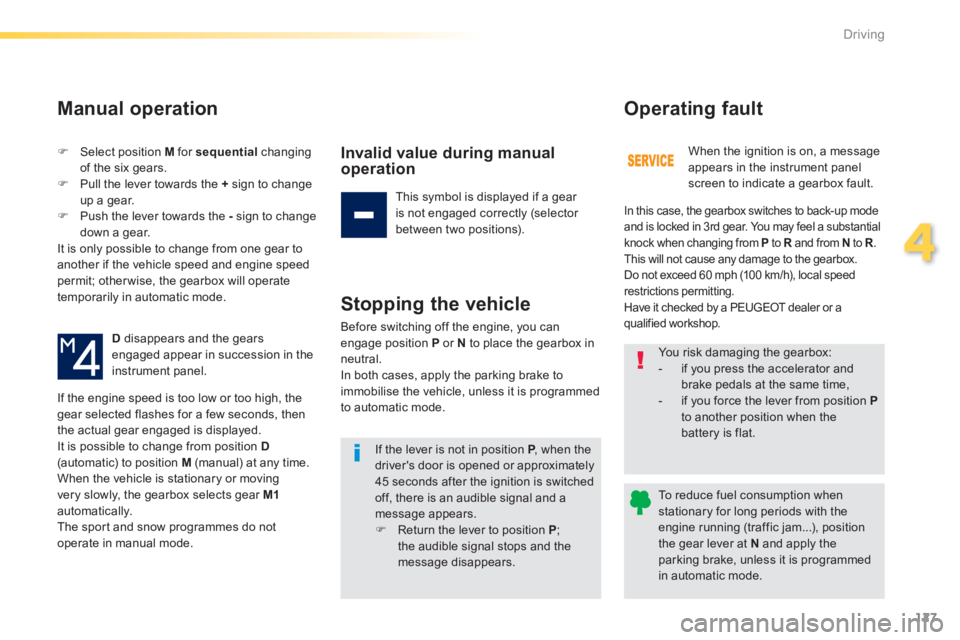
127
4
Driving
308_EN_CHAP04_CONDUITE_ED02-2013
Select position M for sequential changing of the six gears. Pull the lever towards the + sign to change up a gear. Push the lever towards the - sign to change down a gear. It is only possible to change from one gear to another if the vehicle speed and engine speed permit; otherwise, the gearbox will operate temporarily in automatic mode.
D disappears and the gears engaged appear in succession in the instrument panel.
If the engine speed is too low or too high, the gear selected flashes for a few seconds, then
the actual gear engaged is displayed. It is possible to change from position D(automatic) to position M (manual) at any time. When the vehicle is stationary or moving very slowly, the gearbox selects gear M1automatically. The sport and snow programmes do not operate in manual mode.
Manual operation
Invalid value during manual operation
This symbol is displayed if a gear is not engaged correctly (selector between two positions).
Stopping the vehicle
Before switching off the engine, you can engage position P or N to place the gearbox in neutral. In both cases, apply the parking brake to immobilise the vehicle, unless it is programmed
to automatic mode.
If the lever is not in position P , when the P , when the Pdriver's door is opened or approximately 45 seconds after the ignition is switched off, there is an audible signal and a message appears. Return the lever to position P ; the audible signal stops and the message disappears.
When the ignition is on, a message appears in the instrument panel screen to indicate a gearbox fault.
Operating fault
In this case, the gearbox switches to back-up mode and is locked in 3rd gear. You may feel a substantial knock when changing from P to R and from R and from RN to R . R . RThis will not cause any damage to the gearbox. Do not exceed 60 mph (100 km/h), local speed restrictions permitting. Have it checked by a PEUGEOT dealer or a qualified workshop.
You risk damaging the gearbox: - if you press the accelerator and brake pedals at the same time, - if you force the lever from position Pto another position when the battery is flat.
To reduce fuel consumption when stationary for long periods with the engine running (traffic jam...), position
the gear lever at N and apply the parking brake, unless it is programmed in automatic mode.
Page 227 of 400
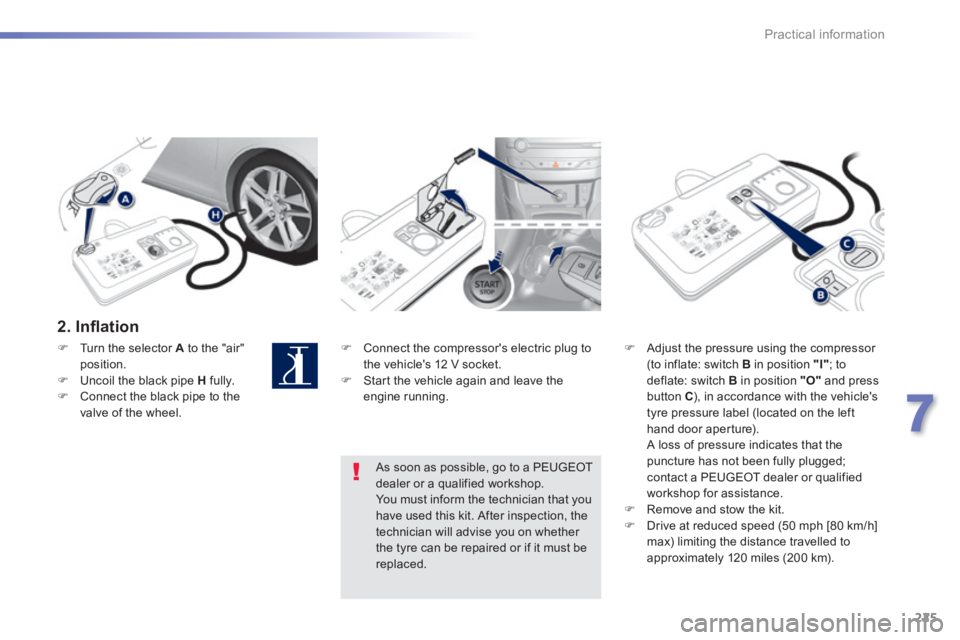
225
7
Practical information
308_EN_CHAP07_INFO PR ATIQUES_ED02-2013
2 . I n fl a t i o n
Connect the compressor's electric plug to the vehicle's 12 V socket. Start the vehicle again and leave the engine running.
Adjust the pressure using the compressor (to inflate: switch B in position "I" ; to deflate: switch B in position "O" and press button C ), in accordance with the vehicle's tyre pressure label (located on the left hand door aperture).
A loss of pressure indicates that the puncture has not been fully plugged; contact a PEUGEOT dealer or qualified workshop for assistance. Remove and stow the kit. Drive at reduced speed (50 mph [80 km/h] max) limiting the distance travelled to approximately 120 miles (200 km).
As soon as possible, go to a PEUGEOT dealer or a qualified workshop. You must inform the technician that you have used this kit. After inspection, the technician will advise you on whether
the tyre can be repaired or if it must be replaced.
Turn the selector A to the "air" position. Uncoil the black pipe H fully. Connect the black pipe to the valve of the wheel.
Page 228 of 400
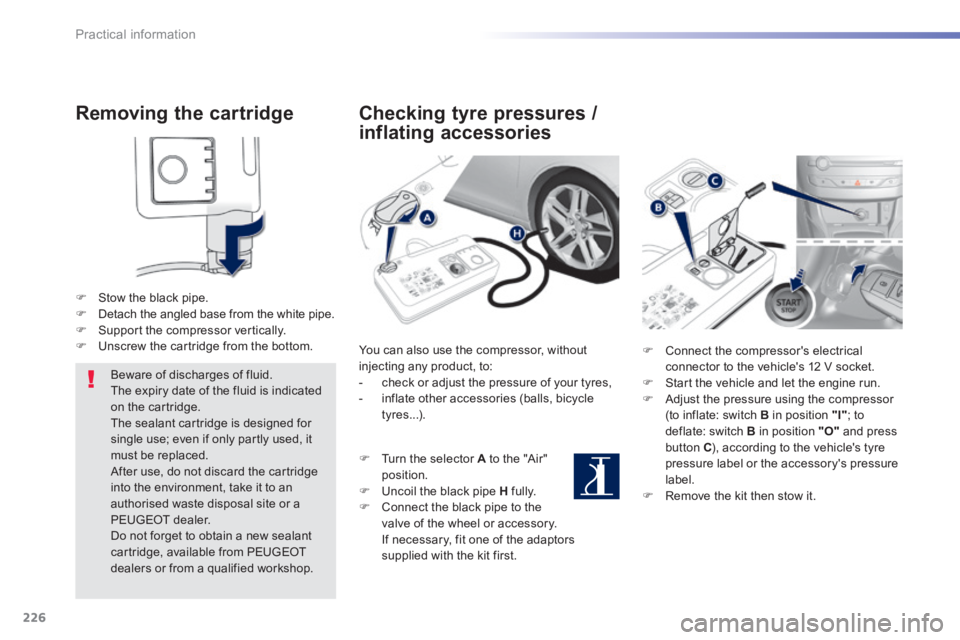
226
Practical information
308_EN_CHAP07_INFO PR ATIQUES_ED02-2013
Removing the cartridge
Stow the black pipe. Detach the angled base from the white pipe. Support the compressor vertically. Unscrew the cartridge from the bottom.
Beware of discharges of fluid. The expiry date of the fluid is indicated on the cartridge. The sealant cartridge is designed for single use; even if only partly used, it must be replaced. After use, do not discard the cartridge into the environment, take it to an authorised waste disposal site or a PEUGEOT dealer.
Do not forget to obtain a new sealant cartridge, available from PEUGEOT dealers or from a qualified workshop.
Checking tyre pressures /
inflating accessories
You can also use the compressor, without injecting any product, to: - check or adjust the pressure of your tyres, - inflate other accessories (balls, bicycle tyres...).
Turn the selector A to the "Air" position. Uncoil the black pipe H fully. Connect the black pipe to the valve of the wheel or accessory. If necessary, fit one of the adaptors supplied with the kit first.
Connect the compressor's electrical connector to the vehicle's 12 V socket. Start the vehicle and let the engine run. Adjust the pressure using the compressor (to inflate: switch B in position "I" ; to deflate: switch B in position "O" and press button C ), according to the vehicle's tyre pressure label or the accessory's pressure label. Remove the kit then stow it.
Page 236 of 400
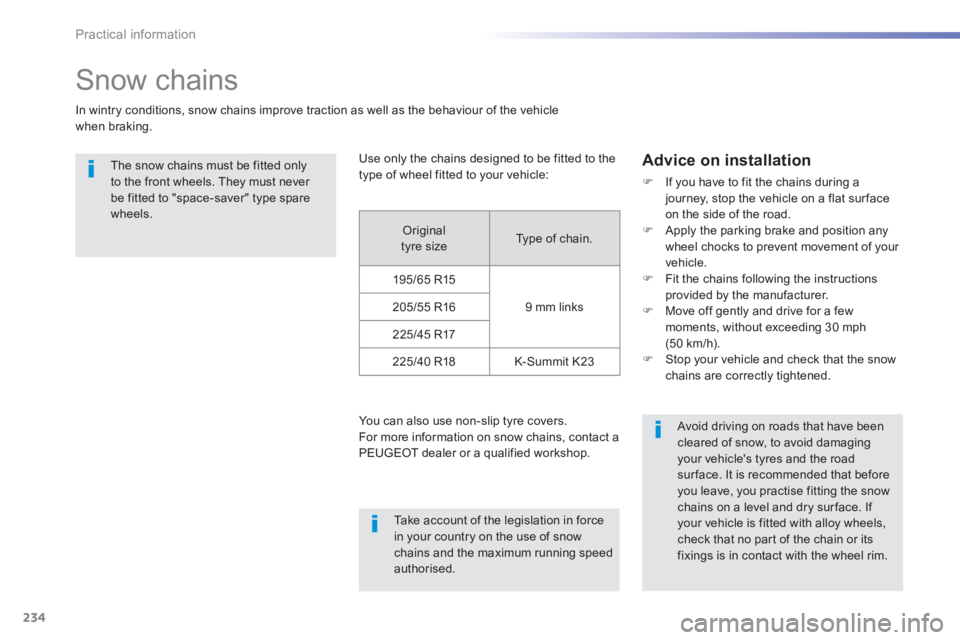
234
Practical information
308_EN_CHAP07_INFO PR ATIQUES_ED02-2013
Snow chains
In wintry conditions, snow chains improve traction as well as the behaviour of the vehicle when braking.
The snow chains must be fitted only to the front wheels. They must never be fitted to "space-saver" type spare wheels.
Take account of the legislation in force in your country on the use of snow chains and the maximum running speed authorised.
Avoid driving on roads that have been cleared of snow, to avoid damaging your vehicle's tyres and the road sur face. It is recommended that before you leave, you practise fitting the snow chains on a level and dry sur face. If your vehicle is fitted with alloy wheels, check that no part of the chain or its fixings is in contact with the wheel rim.
Use only the chains designed to be fitted to the type of wheel fitted to your vehicle:
You can also use non-slip tyre covers. For more information on snow chains, contact a PEUGEOT dealer or a qualified workshop.
Advice on installation
If you have to fit the chains during a journey, stop the vehicle on a flat sur face on the side of the road. Apply the parking brake and position any wheel chocks to prevent movement of your vehicle. Fit the chains following the instructions provided by the manufacturer. Move off gently and drive for a few moments, without exceeding 30 mph (50 km/h). Stop your vehicle and check that the snow chains are correctly tightened.
Original tyre size Type of chain.
195/65 R15
9 mm links 205/55 R16
225/45 R17
225/40 R18 K-Summit K23
Page 255 of 400
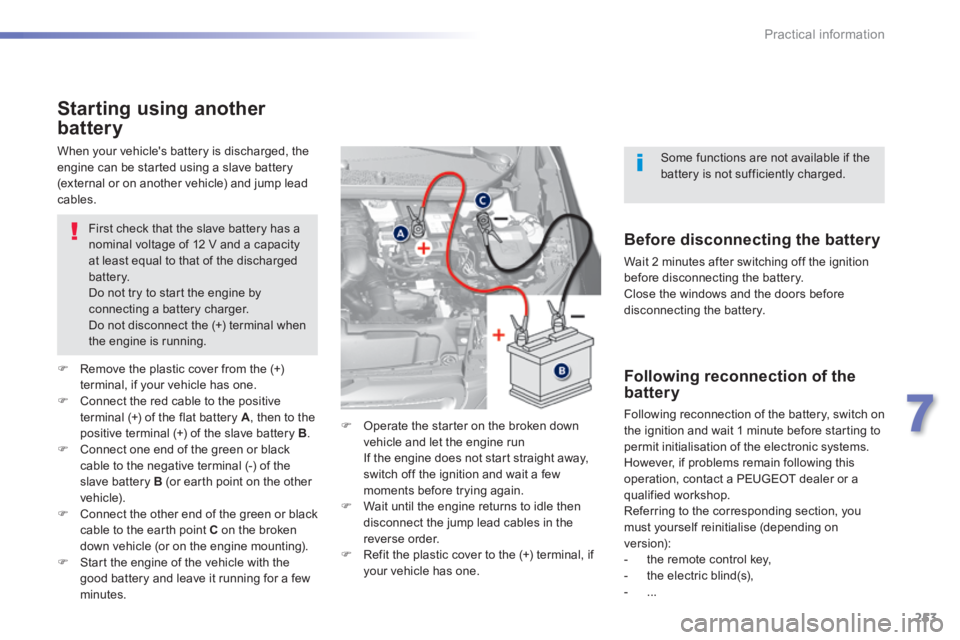
253
7
Practical information
308_EN_CHAP07_INFO PR ATIQUES_ED02-2013
Starting using another
battery
First check that the slave battery has a nominal voltage of 12 V and a capacity at least equal to that of the discharged battery. Do not try to start the engine by connecting a battery charger. Do not disconnect the (+) terminal when the engine is running.
Remove the plastic cover from the (+) terminal, if your vehicle has one. Connect the red cable to the positive terminal (+) of the flat battery A , then to the
positive terminal (+) of the slave battery B . Connect one end of the green or black cable to the negative terminal (-) of the slave battery B (or earth point on the other vehicle). Connect the other end of the green or black cable to the earth point C on the broken down vehicle (or on the engine mounting). Start the engine of the vehicle with the good battery and leave it running for a few minutes.
Operate the starter on the broken down vehicle and let the engine run If the engine does not start straight away, switch off the ignition and wait a few moments before trying again. Wait until the engine returns to idle then disconnect the jump lead cables in the reverse order. Refit the plastic cover to the (+) terminal, if your vehicle has one.
When your vehicle's battery is discharged, the engine can be started using a slave battery (external or on another vehicle) and jump lead cables.
Before disconnecting the battery
Wait 2 minutes after switching off the ignition before disconnecting the battery. Close the windows and the doors before disconnecting the battery.
Following reconnection of the battery
Following reconnection of the battery, switch on
the ignition and wait 1 minute before starting to permit initialisation of the electronic systems. However, if problems remain following this operation, contact a PEUGEOT dealer or a qualified workshop. Referring to the corresponding section, you must yourself reinitialise (depending on version): - the remote control key, - the electric blind(s), - ...
Some functions are not available if the battery is not sufficiently charged.
Page 257 of 400
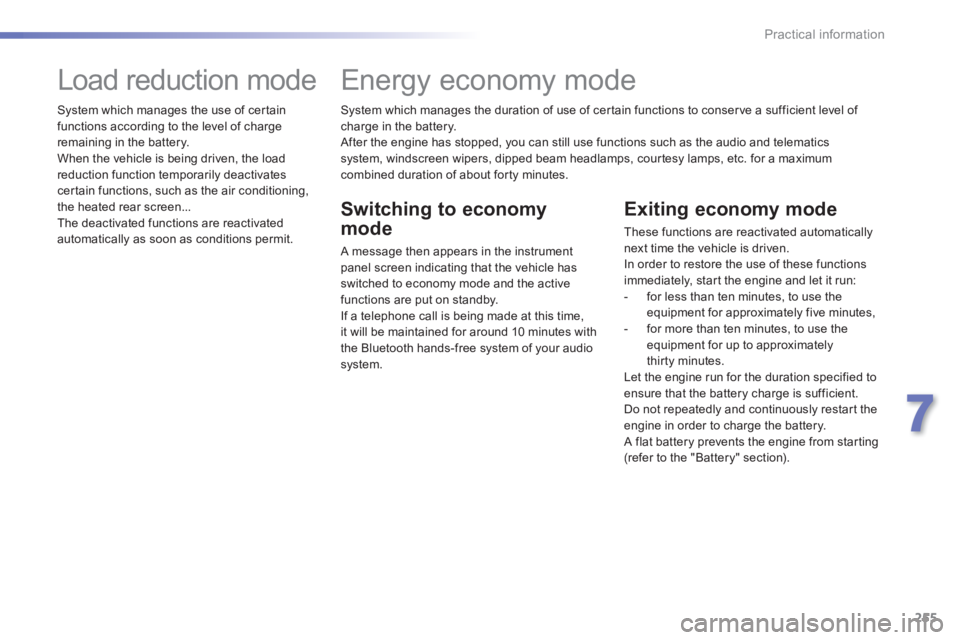
255
7
Practical information
308_EN_CHAP07_INFO PR ATIQUES_ED02-2013
System which manages the duration of use of certain functions to conserve a sufficient level of charge in the battery. After the engine has stopped, you can still use functions such as the audio and telematics system, windscreen wipers, dipped beam headlamps, courtesy lamps, etc. for a maximum combined duration of about forty minutes.
Energy economy mode
Switching to economy
mode
A message then appears in the instrument panel screen indicating that the vehicle has switched to economy mode and the active functions are put on standby.
If a telephone call is being made at this time, it will be maintained for around 10 minutes with the Bluetooth hands-free system of your audio system.
Exiting economy mode
These functions are reactivated automatically next time the vehicle is driven. In order to restore the use of these functions immediately, start the engine and let it run: - for less than ten minutes, to use the equipment for approximately five minutes, - for more than ten minutes, to use the equipment for up to approximately thirty minutes. Let the engine run for the duration specified to ensure that the battery charge is sufficient. Do not repeatedly and continuously restart the engine in order to charge the battery. A flat battery prevents the engine from starting (refer to the "Battery" section).
Load reduction mode
System which manages the use of certain functions according to the level of charge remaining in the battery. When the vehicle is being driven, the load reduction function temporarily deactivates certain functions, such as the air conditioning, the heated rear screen... The deactivated functions are reactivated automatically as soon as conditions permit.